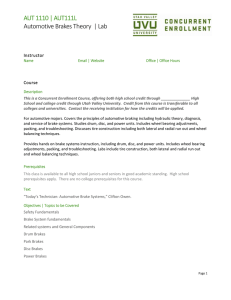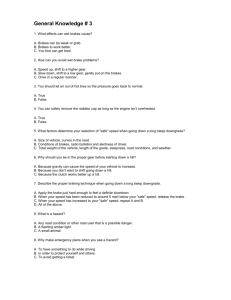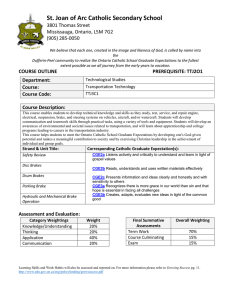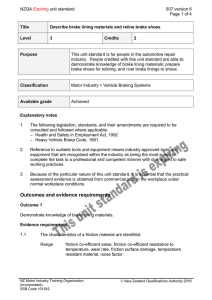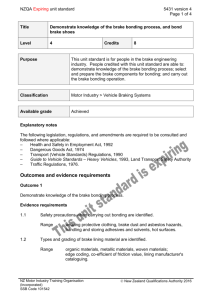NZQA unit standard 15475 version 4
advertisement
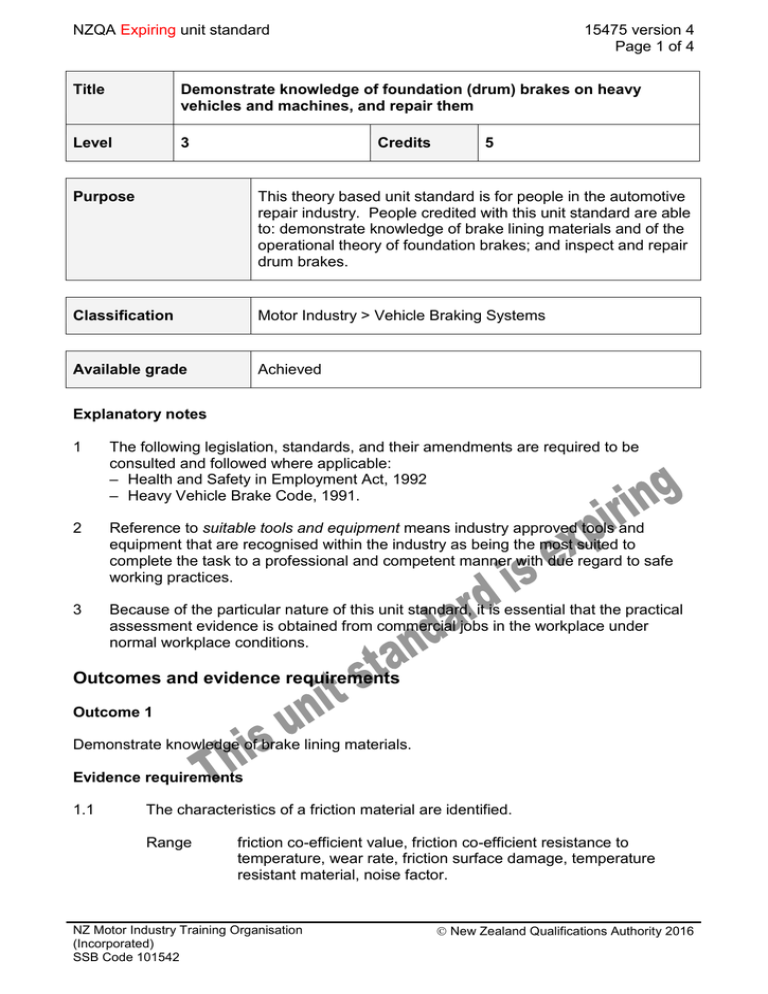
NZQA Expiring unit standard 15475 version 4 Page 1 of 4 Title Demonstrate knowledge of foundation (drum) brakes on heavy vehicles and machines, and repair them Level 3 Credits 5 Purpose This theory based unit standard is for people in the automotive repair industry. People credited with this unit standard are able to: demonstrate knowledge of brake lining materials and of the operational theory of foundation brakes; and inspect and repair drum brakes. Classification Motor Industry > Vehicle Braking Systems Available grade Achieved Explanatory notes 1 The following legislation, standards, and their amendments are required to be consulted and followed where applicable: – Health and Safety in Employment Act, 1992 – Heavy Vehicle Brake Code, 1991. 2 Reference to suitable tools and equipment means industry approved tools and equipment that are recognised within the industry as being the most suited to complete the task to a professional and competent manner with due regard to safe working practices. 3 Because of the particular nature of this unit standard, it is essential that the practical assessment evidence is obtained from commercial jobs in the workplace under normal workplace conditions. Outcomes and evidence requirements Outcome 1 Demonstrate knowledge of brake lining materials. Evidence requirements 1.1 The characteristics of a friction material are identified. Range friction co-efficient value, friction co-efficient resistance to temperature, wear rate, friction surface damage, temperature resistant material, noise factor. NZ Motor Industry Training Organisation (Incorporated) SSB Code 101542 New Zealand Qualifications Authority 2016 NZQA Expiring unit standard 1.2 The categories of brake lining materials are described according to lining manufacturer’s specifications. Range 1.3 fade resistance, recovery, delayed fade, stability, wet friction. The precautions for handling brake linings are described according to manufacturer’s instructions. Range 1.6 edge code – friction identification, compound identification, manufacturer identification. The capabilities of lining materials are described according to lining manufacturer’s specifications. Range 1.5 organic materials, metallic materials, semi-metallic materials. The way in which brake lining materials are identified is described according to lining manufacturer’s specifications. Range 1.4 15475 version 4 Page 2 of 4 contamination from grease and oil, precautions against inhaling brake dust. Methods and procedure of fixing linings to shoes and pads are identified according to manufacturer’s instructions. Outcome 2 Demonstrate knowledge of the operational theory of foundation brakes. Evidence requirements 2.1 The layout of drum brakes is described according to manufacturer’s workshop manuals. Range 2.2 The operating mechanisms of drum brakes are described according to manufacturer’s workshop manuals. Range 2.3 leading trailing shoe, two leading shoe, duo servo brake, two trailing shoe brake. “S” cam, “Z” cam, wedge expanders, hydraulic slave cylinders, slack adjusters. The operation of drum brakes is described according to manufacturer’s workshop manuals. Range leading trailing shoe, two leading shoe, duo servo brake, two trailing shoe brake; hydraulic activation, pneumatic activation, mechanical activation. NZ Motor Industry Training Organisation (Incorporated) SSB Code 101542 New Zealand Qualifications Authority 2016 NZQA Expiring unit standard 2.4 15475 version 4 Page 3 of 4 Methods of park brake activation are described according to manufacturer’s workshop manuals. Range spring brakes, drive shaft brakes. Outcome 3 Inspect and repair drum brakes. Evidence requirements 3.1 Suitable tools and equipment are selected and used to enable the brakes to be inspected and repaired. 3.2 Safety precautions are taken when repairing foundation brakes. Range 3.3 chocking vehicle, raising and supporting vehicle, cleaning. Brake components are inspected for condition and compared against manufacturer’s specifications. Range drum ovality, drum condition, lining thickness, brake spring tension. 3.4 Brake drums are removed according to manufacturer’s workshop manual instructions. 3.5 Activating mechanisms are inspected and repaired according to manufacturer’s workshop manual instructions. 3.6 The operation of brake adjusters is inspected according to manufacturer’s workshop manual instructions. 3.7 Drum brake components are repaired, replaced, and reassembled according to manufacturer’s workshop manual instructions. Replacement information This unit standard has been replaced by unit standard 24407, unit standard 24418, and unit standard 24419. This unit standard, unit standard 15478, unit standard 15479, and unit standard 15480 replaced unit standard 2323. This unit standard is expiring. Assessment against the standard must take place by the last date for assessment set out below. NZ Motor Industry Training Organisation (Incorporated) SSB Code 101542 New Zealand Qualifications Authority 2016 NZQA Expiring unit standard 15475 version 4 Page 4 of 4 Status information and last date for assessment for superseded versions Process Version Date Last Date for Assessment Registration 1 21 February 1999 31 December 2016 Review 2 25 January 2008 31 December 2016 Rollover 3 19 November 2010 31 December 2016 Rollover 4 18 February 2016 31 December 2020 Consent and Moderation Requirements (CMR) reference 0014 This CMR can be accessed at http://www.nzqa.govt.nz/framework/search/index.do. Please note Providers must be granted consent to assess against standards (accredited) by NZQA, or an inter-institutional body with delegated authority for quality assurance, before they can report credits from assessment against unit standards or deliver courses of study leading to that assessment. Industry Training Organisations must be granted consent to assess against standards by NZQA before they can register credits from assessment against unit standards. Providers and Industry Training Organisations, which have been granted consent and which are assessing against unit standards must engage with the moderation system that applies to those standards. Consent requirements and an outline of the moderation system that applies to this standard are outlined in the Conesnt and Moderation Requirements (CMR). The CMR also includes useful information about special requirements for organisations wishing to develop education and training programmes, such as minimum qualifications for tutors and assessors, and special resource requirements. NZ Motor Industry Training Organisation (Incorporated) SSB Code 101542 New Zealand Qualifications Authority 2016
